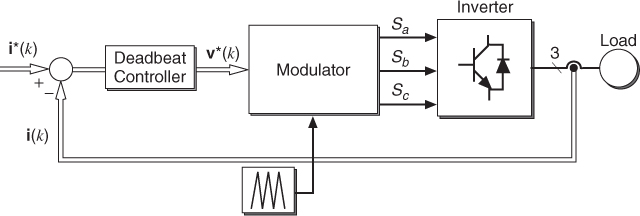13.4 Deadbeat Control with Pulse Width Modulation
13.4.1 Control Scheme
Deadbeat control is one of the most well-known predictive control methods, and was proposed almost two decades ago [8, 9]. A typical control scheme for this method is shown in Figure 13.4. The main advantages of this control scheme are fast dynamic response and the possibility to use any modulation method such as PWM or space vector modulation (SVM). However, deadbeat control in its basic implementation is very sensitive to variations in the load parameters.
Figure 13.4 Deadbeat control with PWM block diagram

The simple model (13.1) can be expressed in matrix notation where the currents in the stationary frame are considered as state variables as follows:
where iα and iβ are the components of the load current vector i, and vα and vβ are the components of the inverter voltage vector v.
Under the assumption that the variables are constant between sampling instants, the system (13.3) can be discretized as follows:
where
13.5 ![]()
13.6
and T is the sampling time.
Based on the discrete-time model (13.4), the ...
Get Predictive Control of Power Converters and Electrical Drives now with the O’Reilly learning platform.
O’Reilly members experience books, live events, courses curated by job role, and more from O’Reilly and nearly 200 top publishers.

